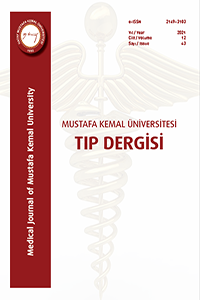The Diagnostic Evaluation of Patients with Hereditary Ataxia in Children: Thirteen Patients and Comprehensive Approach
Öz
Objective: This study aims to determine genotype-phenotype characteristics that can help diagnose hereditary ataxia, a rare disease.Methods: The findings of clinical, laboratory, electrophysiological, and magnetic resonance imaging of thirteen patients with ataxia in the last five years were reported in this study. Phenotypic expressions in patients with the genetically proved mutation were also reviewed.Results: We report four patients identified with Friedreich’s ataxia (FA) and four patients diagnosed with ataxia-telangiectasia (AT), one patient with spinocerebellar ataxia (SCA) type 42, one patient with Marinesco-Sjögren syndrome (MSS), two patients diagnosed with recently defined BRF 1 gene-related Cerebellofaciodental syndrome and one patient with ataxia-oculomotor apraxia (AOA) type 1. Clinical findings, neuroimaging, alpha-fetoprotein levels and electrophysiological findings were first-step tests in diagnostic evaluation. The diagnosis was defined in 85% of all patients with genetic studies.Conclusion: A systematic investigation is recommended for definitive diagnosis in patients with hereditary ataxia. Age at onset of symptoms, prognosis, hereditary pattern of ataxia and clinical findings leads to choosing the ancillary tests, imaging, and genetic studies. The exome sequencing is not an all-knowing test and may fail to find trinucleotide repeats, large deletion and duplications. Specific genetic studies, including single-gene sequencing, microarray methods, should be kept in mind.
Anahtar Kelimeler
Kaynakça
- Paymaan J. N. SMM, Huda Y. Z. The Cerebellum and the Hereditary Ataxias. In: Swaiman KF, editor. Swaiman’s Pediatric Neurology2018. p. 1564-94.
- Palau F, Espinós C. Autosomal recessive cerebellar ataxias. Orphanet J Rare Dis. 2006;1:47. https://doi.org/10.1186/1750-1172-1-47
- Fogel BL. Childhood cerebellar ataxia. J Child Neurol. 2012;27(9):1138-45. https://doi.org/10.1177/0883073812448231
- Ignatius E, Isohanni P, Pohjanpelto M, Lahermo P, Ojanen S, Brilhante V, et al. Genetic background of ataxia in children younger than 5 years in Finland. Neurology Genetics. 2020;6:e444. https://doi.org/10.1212/NXG.0000000000000444
- Vedolin L, Gonzalez G, Souza CF, Lourenço C, Barkovich AJ. Inherited Cerebellar Ataxia in Childhood: A Pattern-Recognition Approach Using Brain MRI. American Journal of Neuroradiology. 2013;34(5):925-34. https://doi.org/10.3174/ajnr.A3055
- Anheim M, Fleury M, Monga B, Laugel V, Chaigne D, Rodier G, et al. Epidemiological, clinical, paraclinical and molecular study of a cohort of 102 patients affected with autosomal recessive progressive cerebellar ataxia from Alsace, Eastern France: implications for clinical management. Neurogenetics. 2010;11(1):1-12. https://doi.org/10.1007/s10048-009-0196-y
- Myftiu B, Baslo M, Orhan E. Electrophysiological study of patients with spinocerebellar and Friedreich’s ataxia. Neurological Sciences and Neurophysiology. 2018;35:138-44. https://doi.org/10.5152/NSN.2018.11239
- Schon K, van Os NJH, Oscroft N, Baxendale H, Scoffings D, Ray J, et al. Genotype, extrapyramidal features, and severity of variant ataxia-telangiectasia. Ann Neurol. 2019;85(2):170-80. https://doi.org/10.1002/ana.25394
- Borck G, Hög F, Dentici ML, Tan PL, Sowada N, Medeira A, et al. BRF1 mutations alter RNA polymerase III-dependent transcription and cause neurodevelopmental anomalies. Genome Res. 2015;25(2):155-66. https://doi.org/10.1101/gr.176925.114
- Castellotti B, Mariotti C, Rimoldi M, Fancellu R, Plumari M, Caimi S, et al. Ataxia with oculomotor apraxia type1 (AOA1): novel and recurrent aprataxin mutations, coenzyme Q10 analyses, and clinical findings in Italian patients. neurogenetics. 2011;12(3):193-201 https://doi.org/10.1007/s10048-011-0281-x
Öz
Amaç: Bu çalışmanın amacı, oldukça nadir görülen kalıtsal ataksilerin genotip-fenotip özelliklerini tanımlayarak tanı koyma sürecine yardımcı olmaktır.Yöntem: Son beş yıl içinde kalıtsal ataksi tanısıyla izlenen hastaların klinik, laboratuvar, elektrofizyolojik ve görüntüleme bulguları çeşitli fenotipik görünümleri ve genetik sonuçları sunulmuştur.Bulgular: Dört hasta Friedrich ataksi, dört hasta Ataksi-Telanjiektazi, iki kardeş hasta BRF 1 gen ilişkili Serebellofasiyodental sendrom, bir hasta spinoserebellar ataksi tip 42, bir hasta Marinesco-Scogren sendromu ve bir hasta ataksi okulomotor apraksi tanısı almıştır. Öykü ve muayene bulguları, elektromiyografi, beyin manyetik rezonans görüntüleme, alfa fetoprotein düzeyleri tanı sürecinde kullanılan ilk basamak değerlendirmelerdir. Hastaların %85’inde kesin tanıya genetik testlerle ulaşılmıştır.Sonuç: Kalıtsal ataksili hastaların kesin teşhisinde sistematik ve bütüncül yaklaşım önerilmektedir. Ataksinin başlangıç yaşı, seyri, ailede benzer hastalık varsa kalıtsal geçiş paterni, muayene bulgularına göre seçilecek yardımcı laboratuvar ve görüntüleme yöntemleri; ön tanı oluşturmada ve kesin teşhis için seçilecek genetik testlerin belirlenmesinde oldukça önemlidir. Tüm ekzom analizinin geni kapsamına rağmen nükleotid tekrar hastalıkları, geniş delesyon ve duplikasyonların tespitinde yetersiz kalabileceği unutulmamalıdır.
Anahtar Kelimeler
Kaynakça
- Paymaan J. N. SMM, Huda Y. Z. The Cerebellum and the Hereditary Ataxias. In: Swaiman KF, editor. Swaiman’s Pediatric Neurology2018. p. 1564-94.
- Palau F, Espinós C. Autosomal recessive cerebellar ataxias. Orphanet J Rare Dis. 2006;1:47. https://doi.org/10.1186/1750-1172-1-47
- Fogel BL. Childhood cerebellar ataxia. J Child Neurol. 2012;27(9):1138-45. https://doi.org/10.1177/0883073812448231
- Ignatius E, Isohanni P, Pohjanpelto M, Lahermo P, Ojanen S, Brilhante V, et al. Genetic background of ataxia in children younger than 5 years in Finland. Neurology Genetics. 2020;6:e444. https://doi.org/10.1212/NXG.0000000000000444
- Vedolin L, Gonzalez G, Souza CF, Lourenço C, Barkovich AJ. Inherited Cerebellar Ataxia in Childhood: A Pattern-Recognition Approach Using Brain MRI. American Journal of Neuroradiology. 2013;34(5):925-34. https://doi.org/10.3174/ajnr.A3055
- Anheim M, Fleury M, Monga B, Laugel V, Chaigne D, Rodier G, et al. Epidemiological, clinical, paraclinical and molecular study of a cohort of 102 patients affected with autosomal recessive progressive cerebellar ataxia from Alsace, Eastern France: implications for clinical management. Neurogenetics. 2010;11(1):1-12. https://doi.org/10.1007/s10048-009-0196-y
- Myftiu B, Baslo M, Orhan E. Electrophysiological study of patients with spinocerebellar and Friedreich’s ataxia. Neurological Sciences and Neurophysiology. 2018;35:138-44. https://doi.org/10.5152/NSN.2018.11239
- Schon K, van Os NJH, Oscroft N, Baxendale H, Scoffings D, Ray J, et al. Genotype, extrapyramidal features, and severity of variant ataxia-telangiectasia. Ann Neurol. 2019;85(2):170-80. https://doi.org/10.1002/ana.25394
- Borck G, Hög F, Dentici ML, Tan PL, Sowada N, Medeira A, et al. BRF1 mutations alter RNA polymerase III-dependent transcription and cause neurodevelopmental anomalies. Genome Res. 2015;25(2):155-66. https://doi.org/10.1101/gr.176925.114
- Castellotti B, Mariotti C, Rimoldi M, Fancellu R, Plumari M, Caimi S, et al. Ataxia with oculomotor apraxia type1 (AOA1): novel and recurrent aprataxin mutations, coenzyme Q10 analyses, and clinical findings in Italian patients. neurogenetics. 2011;12(3):193-201 https://doi.org/10.1007/s10048-011-0281-x
Ayrıntılar
| Birincil Dil | İngilizce |
|---|---|
| Konular | Klinik Tıp Bilimleri |
| Bölüm | Original Articles |
| Yazarlar | |
| Yayımlanma Tarihi | 19 Ağustos 2021 |
| Gönderilme Tarihi | 18 Nisan 2021 |
| Kabul Tarihi | 15 Haziran 2021 |
| Yayımlandığı Sayı | Yıl 2021 Cilt: 12 Sayı: 43 |

